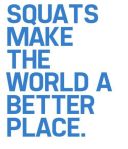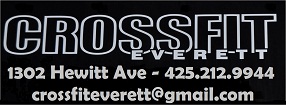Squatting Myths That Refuse to Die – Part 3
if you miss the post on Myth #1 or Myth #2, you can check it out here and here before going on to #3.
From the folks at Biomechfit.com, more on our favorite topic – the squat!
Myth #3: Squats are bad for your back
This is like saying food makes you fat. The idea that squats will hurt your back gets perpetuated by people who perform squats incorrectly, and sometimes by woefully misinformed professionals who claim to know what they are talking about. A recent article posted on Journal Sentinal Online titled, in part, “Squat lifts likely cause of stress fractures in young athletes” claims that performing squats with good form puts the spine at risk of injury, based on a new study. The main problem with the study they reference is that the researchers don’t know how to properly perform a squat. The pars fracture cited as the predominant injury risk is typically an overuse injury involving hyperextension of the spine, and the increase in “sacral slope” they measured is another indication of hyperextension.
By contrast, the goal in any squat should be to maintain a neutral spine. If there is hyperextension of the spine, then the squat is not being performed correctly. Furthermore, as the weight gets heavy in a squat, the challenge is to resist excessive spinal flexion, not extension. It’s much more common to observe a lifter who is rounding their back when squatting, even when lighter loads are being used. This error can easily be corrected by learning proper form and using a manageable resistance. That study and related article fail on such a massive scale, yet the faulty arguments still have the potential to exert undue influence on the general public for many years to come.
Other concerns focus on spinal compression in the squat, and again with the back squat usually being singled out. Some individuals will assert that placing a load on the back is an unnatural movement that should be avoided. The truth is, the human spine is very capable of handling compressive forces. The trick is to load the spine without creating excessive shear, which can be accomplished by keeping the torso as upright as possible (and practical, considering which squatting variation is being used), as well as by keeping the spine in neutral. The ability to maintain an erect torso with a neutral spine will be the limiting factor in the squat for most people. This need not be interpreted as a reason to avoid the squat, though. It simply requires that more attention be given to proper form instead of the amount of weight being lifted. If squats hurt your back and you haven’t had a recent injury or chronic pain issue, then you need to fix your squat. My suggestion is to seek advice from someone who knows how to squat!
Safe squatting and mythbusting basics
Can I promise that no one will ever get hurt doing squats? Well, no, there are no absolute guarantees, and freak accidents do happen. Even the idea that you won’t get hurt if you’re bigger and stronger sounds nice in theory, but in reality it’s impossible to predict and/or protect against all injuries. You can be sure, however, that when you squat correctly, your chance of injury will be very, very slim. Properly supervised weight training has been shown to have an extremely low risk of injury, lower than soccer, rugby, basketball, football, gymnastics, tennis, and even badminton. This may seem surprising or even hard to believe, especially if you’ve gotten hurt while lifting weights, but it makes sense if you understand that weight training can and should be performed in a much more controlled environment, absent the chaos and unpredictability inherent to many sports. Weight lifting injuries can be avoided 99.99% of the time.
There are two basic tips that will help you squat safely and I’ve already referred to them in this article. The first is to squat with proper form, simple as that. Admittedly, the squat can be a tricky movement to master, especially the back squat. How do you know if your form is good? The video in my previous post about Hip Drive should give you a good idea of how a squat should look, comparing three different squat variations. If anything hurts when you squat or the movement feels awkward or imbalanced, those are good indications that you’re doing something wrong or using too much weight. And very importantly, if your lower back is rounding at the bottom of your squat, that is an issue that needs to be addressed before you start adding more weight. I explain how to do this in my post about maintaining a neutral spine in the squat. Take whatever time is necessary to learn proper form.
The second tip is to squat within your limits, adding resistance conservatively. This will allow your body to recover and adapt, a concept that is completely ignored when you read or hear about the supposed dangers of squatting. Amazingly, your body will adapt to the demands placed upon it, as long as you don’t exceed its current ability or its capacity for recovery. Usually, this is more of an issue with men, for whom its tempting to add 50, 75, or 100 lbs. at a time to the bar in an attempt to force progress or prove their masculinity. (Women typically go in the opposite direction, hesitating to add much weight at all out of an irrational fear of getting big and bulky and losing their femininity, another stubborn myth that has no basis in reality.) A good way to avoid this mentality is to approach each squatting session as an opportunity to practice the squat, rather than a chance to show off how much weight you can lift. That’s a bonus tip: keep your ego in check.










